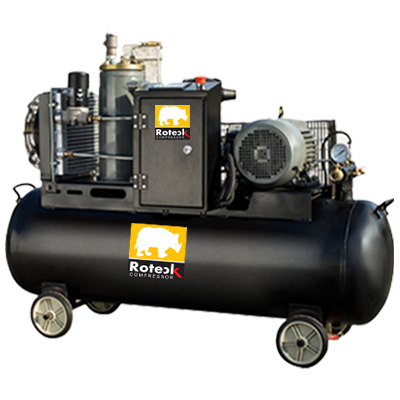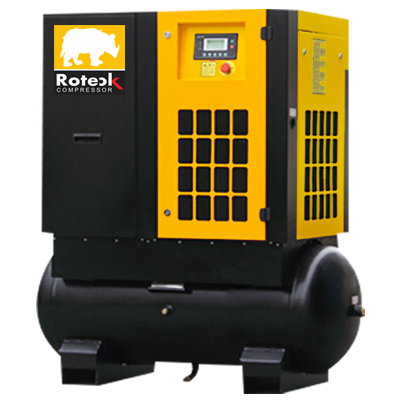Reciprocating compressors are positive displacement machines. A reciprocating compressor uses a piston to compress the air. This compressor generates pulses of compressed air or gas that are discharged into the piping that passes the air or gas to its point used.

Things you have to know about Reciprocating Compressor
Reciprocating compressors are expensive compressors but when we talk about quality it comes at top of the list of company choice. In this compressors, Piston helps in compressing the air in a cylinder with one way valves and pumps into an air chamber.
Reciprocating compressor saw where there is a requirement of high pressure and low flow. Reciprocating compressors or piston compressors are positive displacement machines that work on the concept of reciprocation by compressing and displacing element. Reciprocating compressors use cylinders with pistons built-in.
In short, each cylinder consists of closed ends next to the plate and is finished at the opposite end with a movable piston. The valves (suction and delivery valve) of the cylinders are located underneath the compressor’s valve pockets. During the primary stage of compression, air moves into the cylinder via a suction valve, triggered by the movement of the piston. This creates a vacuum. Once the cylinder’s interior pressure exceeds the pressure within the discharge pipes, valves open and permit the air out of the cylinder.
Principle of Reciprocating Compressor
Reciprocating compressors usually draw power from diesel. This could be by way of a direct-drive or a belt drives system, either of which can be in continuous operation as long because the engine is on. The whole cycle works by a mechanism for unloading.
A volume of gas is drawn into a cylinder in this air compressor, it is trapped and compressed by piston and then discharged into the discharge line. The cylinder values control the flow of gas through the cylinder, these valves act as check valves. Let’s take a look at reciprocating compressor basics.

- The Intake Cycle
It starts with the piston which is pulled downward by the help of cylinder. This motion produces a vacuum between the pistons top and therefore, the head of the cylinder, bringing lower pressure air into the cylinder through a series of inlet valves. These valves are located above the piston head because it descends. During this a part of the cycle, inlet valves stay open and discharge valves stay closed.
In Reciprocating Compressor, The piston then moves back upward, prompting inlet valves to shut so air is trapped within the cylinder, because the piston continues to push upward, the world that air occupies within the cylinder is reduced, leading to pressurize the air.
The pressure of the air inside the cylinder will pass by opening the valve and allowing the pressurized air to exit. A closed discharge valve serves to dam air from moving into the low-pressure a part of the cylinder after it’s been pressurized. The air exiting the discharge port then cycles through an air receiver tank to free the low-frequency pulsation it acquired during compression.
- The Unloading Process
Once the pressure control device senses that the air within the receiving tank has reached the air mass cut-out threshold, it signals the compressor to unload. Unloading is also full or partial, counting on the reciprocating compressor design.
Even so, As down-stream machinery uses the newly compressed gas, the force per unit area of the tank will gradually reduce. Once it falls to the re-surmised load point, the control contrivance sanctions the compressor to re-start the compression cycle and build the tank pressure up once again.
- The Duty Cycle
The duty cycle is set by taking the time compressor spends on loading and comparing it to the time the machine runs. Reciprocating compressors are only designed for a full load time and may be unloaded the remain of the time.
The duty cycle tells to the measure of time a compressor can be worked in a given time-frame at 100 PSI, and a standard surrounding temperature of 72° F. It is usually communicated in rate design: Compressor on schedule ÷ (on a schedule + off time) = Duty Cycle %.
- Lubrication
Not every reciprocating compressor design works like any other compressor design, during this design, the provision from the sump is crucial to keep the full system lubricated and functioning properly. In this configuration, you had have to alter the lubricant change out intervals recommended by the engine suppliers.
As they had not taken into consideration the additional needs of the compressor. The new schedule must consider the warmth load that the compressor adds to the lubricant if you would like to induce an accurate gauge of the lubricant’s lowered life.
- Cooling
In this case, for the most air compressors powered by the engines, the first cooling source for the system is the lubricant. The engine oil cooler cools the lubricant, by recycling through the compressor. Airflow from the fan within the engine oil cooler can even eliminate a tiny low portion of the warmth the compressor body releases, removing it from the system together with discharged exhaust air.
The cooling methods are crucial to the longevity of the equipment. Without them, the danger of an increase in temperature limitations is much more if your application surpasses the recommended duty cycle. Whenever lubricant becomes too hot and also the temperature exceeds manufacturer recommendation, the lubricant could break down prematurely. This implies having to alter the lubrication more often at the best and early failure of components within the compressor and engine at the worst.
Type of Reciprocating Compressor
- Single and double acting reciprocating compressor
In the same way it depends on the number of compression stages, therefore, there are two stages single and double.
Double-acting compressors have cross heads which help in generating a pure strait movement after the crankshaft & connection rod. This type of technology is only used in heavy-duty industrial. On the other hand, Single-acting reciprocating compressors are old and most common compressors. They are basically small in size.
- Single stage and vs two stage reciprocating compressor
Likewise the major distinction between a single and a two-stage compressor is the number of times the compressor compresses the air. In a single stage the air gets compressor only once, but in a two stage the air is compressed twice which doubles the pressure. They both use two cylinders for balancing the air, but there is one difference which makes them different i.e., In the Single stage the cylinders are of same size, in the two stages the second piston is shorter as compared to the first piston.
It also consists of a cooling tube to cool the air before the second stage of compression. A two-stage compressor has the potential to produce higher pressure of air. They are mostly used for industrial settings and Industrial applications.
- Diaphragm Reciprocating compressor
- It is another form of a reciprocating compressor that uses a flexible membrane which is made up of rubber or silicone instead of a metal piston to compress the air.
- In short A Diaphragm compressor is a variation of the exemplary responding blower with reinforcement and cylinder rings and pole seal. The pressure of gas happens by methods for an adaptable layer, rather than an admission component. The to and fro moving film is driven by a pole and a driving rod component.
However which one you will choose- Reciprocating Compressor or Screw Air Compressor
| Reciprocating (Piston type ) Air Compressor | Screw Air Compressor |
| Reciprocating compressors use piston driven by a crankshaft to compress the air. | Screw air compressors use two meshing helical screws, known as rotor or air-end, to compress the air. |
| Simple design | Optional designs and have enclosures for noise level reduction. |
| Energy efficiency is less of the above 20HP models. | More airflow at less power consumed. The difference is more beneficial and viable at 20HP and above machines. |
| Generally belt driven (V-belt) which has transmission loss as high as 5%. | Generally, screw compressors have either direct drive or poly-belt drive, which eliminates transmission loss or has very less transmission loss. |
Application of Reciprocating Compressors
- Reciprocating compressors have an immensely colossal role in the industry, which includes natural gas processing and distribution, and oil refineries.
- Compressed gases also play an important role in the refrigeration process, where the next re-expansion of the gas after compression produces the required cooling effect. Many compressed air applications use reciprocating compressors, in the field dental surgeries, the automotive sector, and in the agriculture sector also.
- This compressor (otherwise called cylinder blowers) is, for the most part, used to move air at expanded pressing factor. The primary components of the compressor are at least one chambers, and cylinders which move inside them, fairly like in an interior ignition motor.
Five benefits of Reciprocating Compressors
- Low Maintenance Cost.
- Have high pressure and high power.
- Can be located close to point‐of‐use avoiding lengthy piping runs and pressure drops.
- Durable, efficient and affordable.
- Significant product life.
Although Why Trust Our Company With Your Air Compressors need
Above all, When it comes to your air compressor needs, working with a company you can trust will save money, hassle-free service and bring you better peace of mind. Our goal is to make sure you’re receiving the maximum satisfaction from your compressed air system.

Hi, this is a comment.
To get started with moderating, editing, and deleting comments, please visit the Comments screen in the dashboard.
Commenter avatars come from Gravatar.
Helpful 👍
Thank you!!
Very Helpful!!
Thank you!!